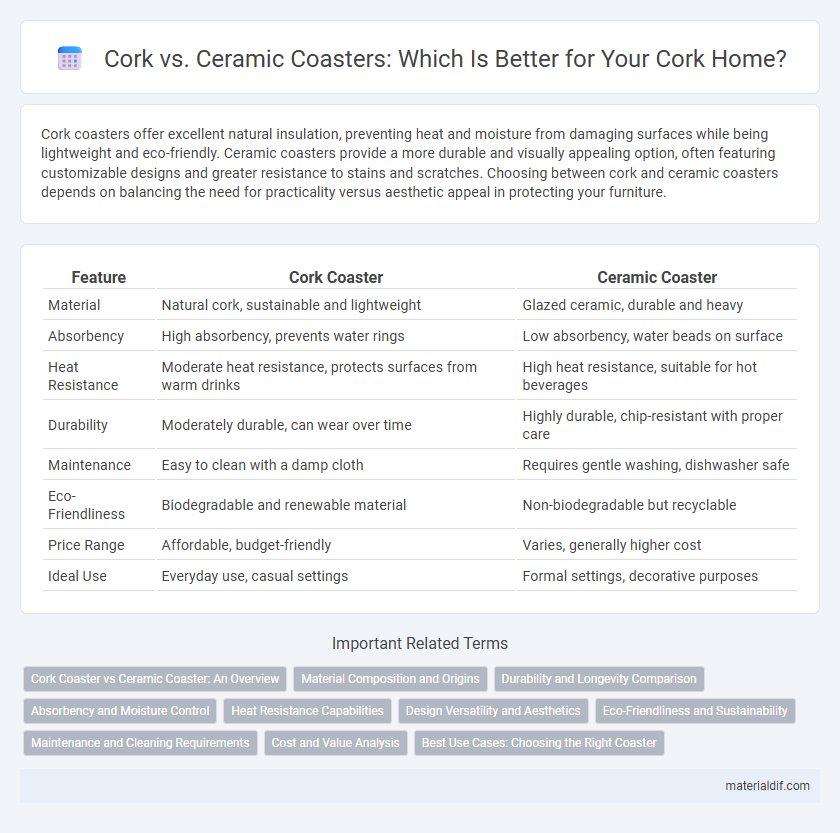Cork coasters offer excellent natural insulation, preventing heat and moisture from damaging surfaces while being lightweight and eco-friendly. Ceramic coasters provide a more durable and visually appealing option, often featuring customizable designs and greater resistance to stains and scratches. Choosing between cork and ceramic coasters depends on balancing the need for practicality versus aesthetic appeal in protecting your furniture.
Table of Comparison
| Feature | Cork Coaster | Ceramic Coaster |
|---|---|---|
| Material | Natural cork, sustainable and lightweight | Glazed ceramic, durable and heavy |
| Absorbency | High absorbency, prevents water rings | Low absorbency, water beads on surface |
| Heat Resistance | Moderate heat resistance, protects surfaces from warm drinks | High heat resistance, suitable for hot beverages |
| Durability | Moderately durable, can wear over time | Highly durable, chip-resistant with proper care |
| Maintenance | Easy to clean with a damp cloth | Requires gentle washing, dishwasher safe |
| Eco-Friendliness | Biodegradable and renewable material | Non-biodegradable but recyclable |
| Price Range | Affordable, budget-friendly | Varies, generally higher cost |
| Ideal Use | Everyday use, casual settings | Formal settings, decorative purposes |
Cork Coaster vs Ceramic Coaster: An Overview
Cork coasters provide excellent absorbency and natural anti-slip properties, making them ideal for protecting surfaces from moisture and scratches. Ceramic coasters offer superior durability and heat resistance, often featuring decorative designs that enhance aesthetic appeal. Both materials serve distinct purposes, with cork favored for functionality and eco-friendliness, while ceramic excels in style and longevity.
Material Composition and Origins
Cork coasters are made from natural cork harvested from the bark of cork oak trees predominantly found in Portugal and Spain, offering a lightweight, renewable, and moisture-resistant surface. Ceramic coasters consist of fired clay materials often glazed for durability and aesthetic appeal, originating from ancient pottery traditions worldwide, including regions like China and the Mediterranean. The organic, porous nature of cork contrasts with the solid, heat-resistant characteristics of ceramic, influencing their functionality and environmental impact.
Durability and Longevity Comparison
Cork coasters offer natural resistance to moisture and heat, making them highly durable for everyday use in Cork households. Ceramic coasters excel in scratch resistance and maintain their aesthetic appeal over time but can chip or crack if dropped. When comparing durability and longevity, cork coasters provide flexible resilience, while ceramic coasters deliver long-lasting protection with a more fragile nature.
Absorbency and Moisture Control
Cork coasters excel in absorbency and moisture control due to their natural porous structure, effectively trapping condensation from cold drinks and preventing surface water damage. Ceramic coasters, while less absorbent, provide a moisture barrier that protects surfaces from spills but can cause liquids to pool without absorbing them. Choosing between cork and ceramic coasters depends on whether you prefer active moisture absorption or a solid, easy-to-clean moisture barrier.
Heat Resistance Capabilities
Cork coasters offer natural heat resistance due to their dense cellular structure, effectively protecting surfaces from hot beverages by absorbing and dispersing heat. Ceramic coasters provide superior heat resistance with high thermal tolerance, preventing heat transfer and making them ideal for extremely hot cups or mugs. While ceramic coasters withstand higher temperatures without damage, cork coasters deliver eco-friendly insulation with better grip and less risk of scratching furniture.
Design Versatility and Aesthetics
Cork coasters offer natural texture and warm tones that complement rustic and eco-friendly decor, excelling in design versatility for both casual and formal settings. Ceramic coasters provide a sleek, glossy finish with endless customization options such as vibrant patterns and intricate artwork, enhancing modern and artistic aesthetics. Choosing between cork and ceramic coasters depends on the desired visual impact and style adaptability in home or office environments.
Eco-Friendliness and Sustainability
Cork coasters are highly eco-friendly, made from renewable cork oak bark that regenerates naturally without harming trees, ensuring sustainable harvesting practices. Ceramic coasters, while durable, require energy-intensive manufacturing and are less biodegradable, making cork the superior choice for environmental sustainability. The biodegradability and low carbon footprint of cork coasters contribute significantly to reducing waste and promoting sustainable living.
Maintenance and Cleaning Requirements
Cork coasters require minimal maintenance, needing only occasional wiping with a damp cloth to remove spills and prevent odor buildup. Ceramic coasters, while more resistant to stains and heat, often need gentle hand washing to avoid chipping or cracking, with some being dishwasher safe depending on the glaze quality. Both types benefit from regular cleaning to maintain hygiene, but cork's natural absorbency demands quicker drying to prevent mold growth.
Cost and Value Analysis
Cork coasters offer an affordable option with excellent moisture absorption and natural non-slip properties, typically priced lower than ceramic coasters. Ceramic coasters, though more expensive due to their durability and customizable designs, provide higher long-term value through resistance to stains and heat. Choosing between the two hinges on balancing initial cost against longevity and aesthetic preferences for Cork coaster users.
Best Use Cases: Choosing the Right Coaster
Cork coasters excel at absorbing moisture and protecting surfaces from condensation, making them ideal for cold drinks and everyday use in homes and offices. Ceramic coasters offer durability and heat resistance, perfect for serving hot beverages like coffee or tea and adding decorative appeal to dining settings. Selecting between cork and ceramic coasters depends on whether moisture absorption or heat resistance and aesthetics are prioritized.
Cork Coaster vs Ceramic Coaster Infographic

 materialdif.com
materialdif.com